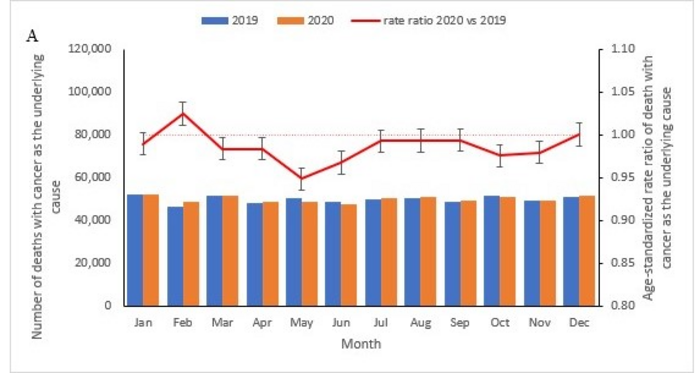Article
Researchers compare cancer, COVID-19 mortality trends in first year of pandemic
Author(s):
Figures confirm ‘high burden’ and disparities in medical care based on race, ethnicity.
© American Cancer Society - EurekaAlert!

Cancer grew as a contributing cause of death for patients who died in 2020, the first year of the COVID-19 pandemic.
Researchers examining cancer mortality for 2019 and 2020 found cancer decreased year-on-year as an underlying cause of death. That continued a decreasing trend happening since 2015.
But cancer increased as a contributing cause of death from 2019 to 2020, bucking a five-year trending decline, according to the study published in the Journal Oncology Practice. The American Cancer Society (ACS) led the study.
“Individuals living with cancer were at higher risk of COVID-19 infection and experiencing more severe symptoms due to their health conditions and treatment-related immune suppression,” lead researcher Jingxuan Zhao, ACS senior associate scientist health services research said in a news release. “The stay-at-home orders and the discontinuation of non-emergency treatment to limit hospital capacity and reduce transmission at the beginning of the pandemic may have resulted in delayed cancer screenings, diagnoses, and treatments, and possibly contributed to increased mortality.”
The findings showed disparities in death with cancer as a contributing cause by race and ethnicity. Those highlighted “the disproportionately high burden of the COVID-19 pandemic and cancer among non-Hispanic Black and Hispanic populations, as they were at higher risk of COVID-19 disease and also face barriers in access to health care compared with non-Hispanic White people because of structural racism,” the study said.
The researchers also examined location and found “the increase in the proportion of. Deaths with cancer listed as a contributing cause mirrored the COVID-19 mortality rates” based on urban and rural residences.
For example, higher rate ratios with cancer as a contributing cause in April 2020 in cities could be linked to the high COVID-19 mortality rates at the beginning of the pandemic. Cancer as a contributing cause grew from July to December 2020 in rural areas, reflecting high COVID-19 mortality rates in rural areas at the same time.
“More research is needed to better understand the reasons for such an increase in deaths with cancer as a contributing cause,” Zhao said. “We need to continue monitoring the long-term cancer-related mortality trends and how the COVID-19 pandemic affected cancer diagnosis and receipt of care.”





